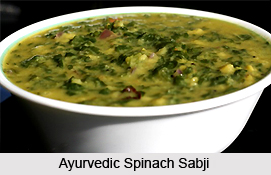 Ayurvedic spinach sabji is nutrition enriched delicious recipe which provides a number of health benefits. Spinach is one of the best sources of iron, vitamin K, vitamin A, vitamin C and folic acid. This dish is appetizing and easy to digest. It is an ideal food for person with kapha prakriti. vata and pitta prakriti person can eat ayurvedic spinach sabji but not often. The primary ingredients of this recipe are spinach, moong dal, safflower oil, cumin seeds, garlic, hing, chilli, salt and water. It is easy to cook and can be prepared at home at any time. Ayurvedic spinach sabji can be consumed by teaming up with rice or roti.
Ayurvedic spinach sabji is nutrition enriched delicious recipe which provides a number of health benefits. Spinach is one of the best sources of iron, vitamin K, vitamin A, vitamin C and folic acid. This dish is appetizing and easy to digest. It is an ideal food for person with kapha prakriti. vata and pitta prakriti person can eat ayurvedic spinach sabji but not often. The primary ingredients of this recipe are spinach, moong dal, safflower oil, cumin seeds, garlic, hing, chilli, salt and water. It is easy to cook and can be prepared at home at any time. Ayurvedic spinach sabji can be consumed by teaming up with rice or roti.
Ingredients of Ayurvedic Spinach Sabji
•Six cups of chopped spinach
•Half cup of yellow moong or tur dal
•Two cups of water
•One tablespoon of safflower oil
•One teaspoon of cumin seeds
•One clove of chopped garlic
•A pinch of salt
•A pinch of hing
•One green chopped chilli
Method of Preparing Ayurvedic Spinach Sabji
To cook Ayurvedic spinach sabji firstly, wash the spinach and the dal twice, put them in a pot with water and cook uncovered until it softens for about half an hour. This is the very first step of preparing ayurvedic spinach sabji. Tur dal may take longer time. Smash the cooked dal and spinach slightly and keep it aside. On the other hand, heat a pan on medium heat and add the oil. Put cumin seeds, mustard seeds, hing, garlic and chilli and cook till the garlic turns brown. And it is ready to serve.
Benefits of Ayurvedic Spinach Sabji
This recipe provides various health benefits. The key benefits are as follows:
•The key ingredient of this recipe which is spinach is loaded with tons of nutrients in a low calorie package. It improves blood glucose control in diabetics, lowers the risk of cancer, lowers blood pressure, improves bone health, and lowers the risk of developing asthma.
•The recipe being roughage helps in digestion and prevents colon cancer.
•It increases appetite and reduces obesity.
•This ayurvedic spinach sabji also helps in the functioning of the lungs and detoxifies the blood making it healthy.




















